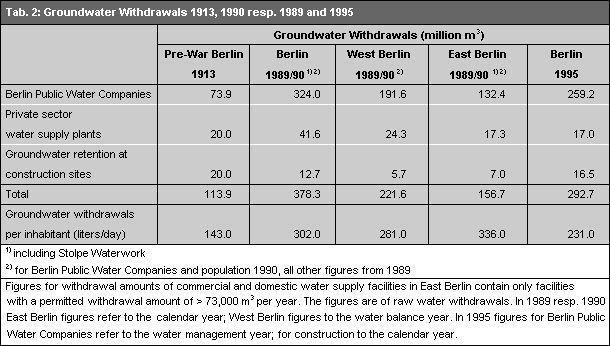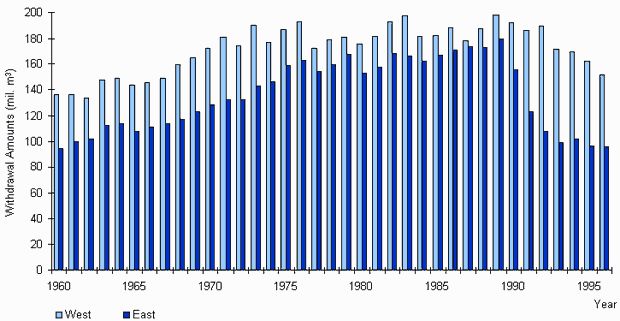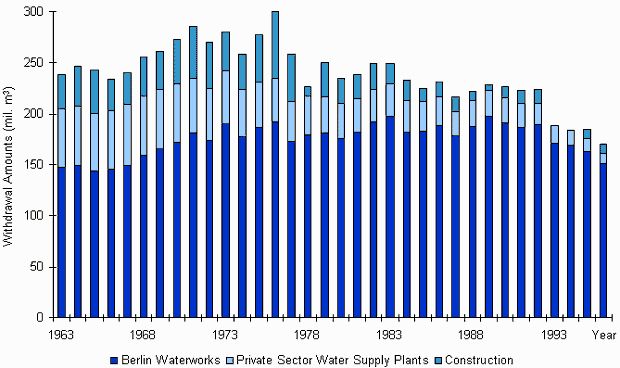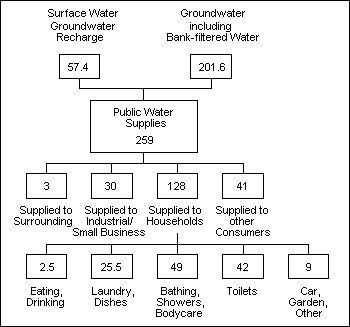In 1989, 12.7 mil. m3 of water was removed by groundwater retention at construction sites. In 1995, the total was 16.5 mil. m3; 7.3 mil. m3 at construction sites in the western part of the city, and 9.2 mil. m3 in in the eastern part. The increase of groundwater removals is due to increased construction in Berlin since 1990.
Groundwater Balance
The goal of water management is to maintain a balanced groundwater balance. That means only so much groundwater should be removed as can be recharged. If removals exceed recharge, the groundwater reservoir will gradually empty; the groundwater level sinks. The West Berlin groundwater level sank strongly in 1950 – 1975, due to large withdrawal amounts of the Berlin Public Water Companies, private sector water supply plants, and groundwater retention at construction sites. The groundwater level has been rising since the mid-70’s (cf. Map 02.07). This is caused by lesser withdrawal amounts of groundwater by private sector water supply plants, and by lesser groundwater removals, as well as groundwater returns, at construction sites.
The Public Water Companies established groundwater recharge plants in order to increase groundwater. These plants were necessary because precipitation and natural bank filtration from surface waters were insufficient to compensate for and balance out groundwater removals. Surface water is discharged in the vicinity of groundwater removal wells, into shallow earthern basins, ponds, or pits. This water then percolates into the groundwater. Natural percolation basins include Kuhlake in the Spandau Forest and the Grunewald chain of lakes (Grunewaldseenkette), which are located in the catchment area of withdrawal wells.
The processing facilities of the Spandau Waterwork receive surface water from the Havel river, process it mechanically and chemically, and then discharge it for percolation at Kuhlake, Kreuzgraben, and the connected channel-pond system. After lake water from the Tegeler See is processed, it is discharged through micro-sieve facilities for percolation at Baumwerder island and at Saatwinkel. The Beelitzhof Waterwork purifies Havel river water in a phosphate elimination facility for discharge into the Schlachtensee lake. This water eventually enters the Grunewald lakes. In the area of the Stolpe Waterwork, Havel river water is dammed onto Havel meadows and percolates.
Groundwater recharge plants injected 57.3 mil. m3 of prepared surface water for percolation in 1995.
Besides “true” and manmade recharged groundwater, a considerable portion of water withdrawn by the Public Water Companies comes from bank filtered water. Wells in the vicinity of surface waters produce cones of depression, and water from the bank areas of the Havel, Dahme and Spree rivers flow into them. The proportion of bank filtered water in the total withdrawal amount of each well gallery depends on the distance of the well from the surface waters. An average of 50 % of the removals of the Berlin Public Water Companies has been assumed. Figure 6 depicts the origin of waters used by the public water supply, as well as a division of its uses. Water consumption from public water supplies per inhabitant in Berlin was 188 liters/day in 1995. Water consumption of Berlin households totalled 161 mil. m3; per inhabitant 128 l/d.




